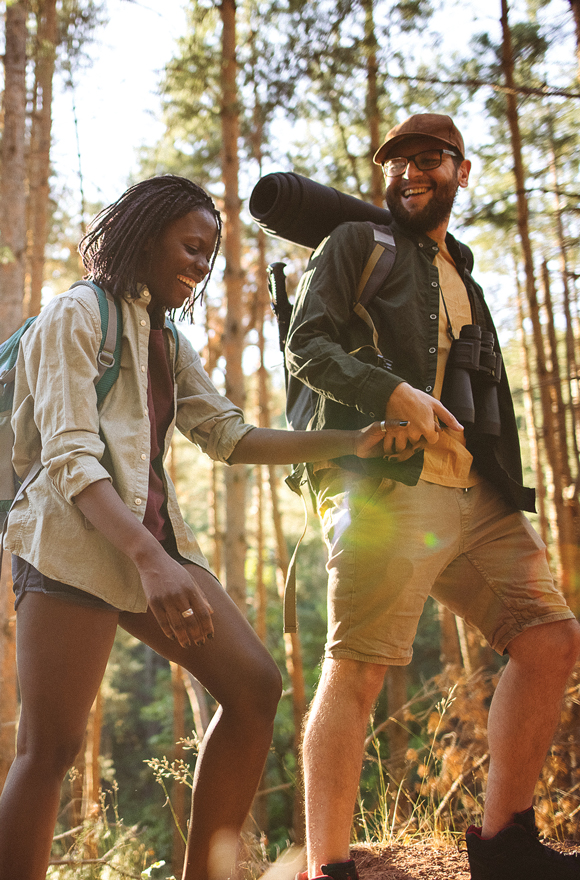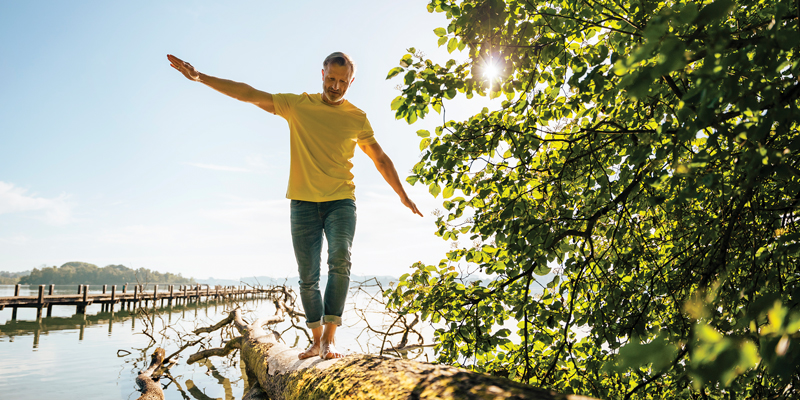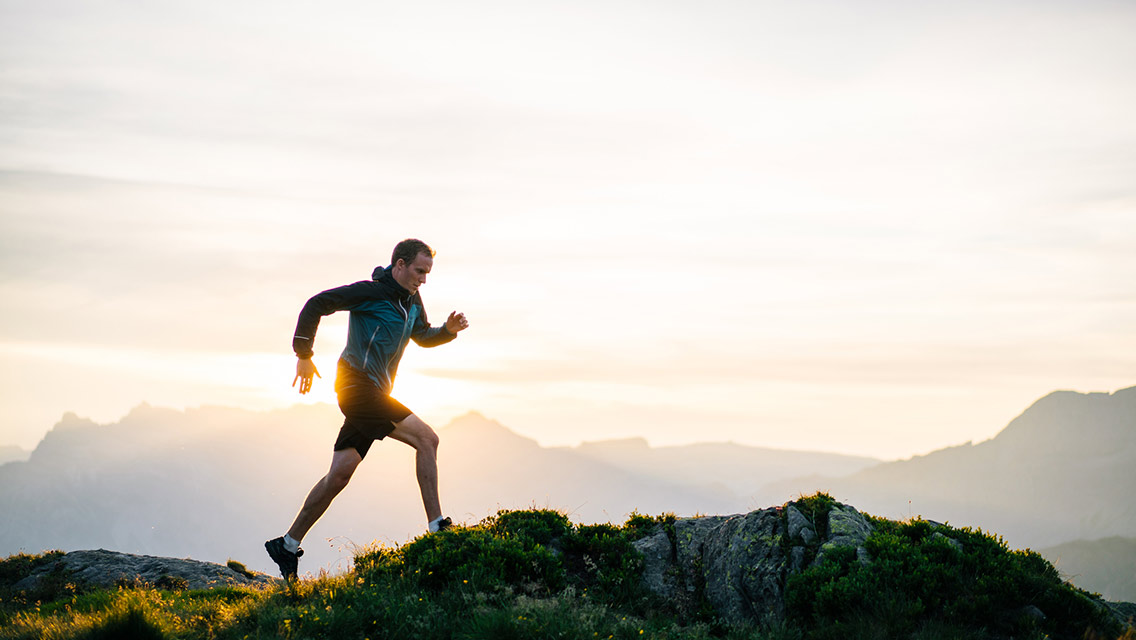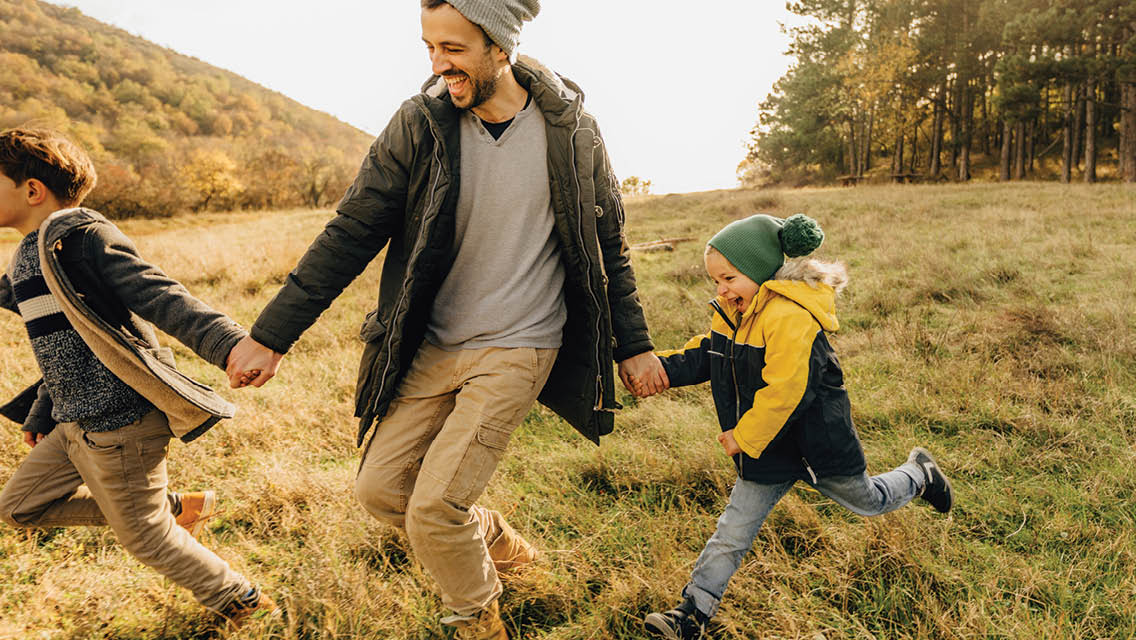Growing up in Maine, surrounded by forests, mountains, lakes, and the ocean, Colleen Verreault learned to embrace the gift of moving her body outdoors. She’s never really considered herself a gym person.
But when she heard about a workout class that meets outside year-round, Verreault, 59, decided to give it a try. One chilly day in December 2024, she drove to WolfPack Fitness, an outdoor gym located on the woodsy shore of a river in Auburn, Maine.
After a friendly welcome from the gym’s owner, Verreault was offered extra gloves and hand warmers, then paired with a partner. Before long, she was hitting tractor tires with a sledgehammer, shaking chains like battling ropes, and carrying buckets of sand up and down a hill. These workouts have since become a constant for Verreault, who attends classes weekly to connect with friends, get stronger, and recharge from hours spent indoors at her desk job.
“It’s fun and it’s different,” she says. “You’re doing the same kinds of exercises as you would in a gym, but outside and in a more creative way. To me, it’s worth being out in the fresh air after being inside all day.”
Working out in any setting is great, but moving your body outside in nature can be especially rewarding. Time spent outdoors has been shown to lower anxiety, improve concentration and creativity, and bring about a deeper sense of connection to the natural world. (Digging in the garden, walking by a river, and enjoying some sun during lunch do more than just lift your spirits — they’re good for your physical health, too. Learn more at “How Nature Boosts Your Health.”)
Physiologically, spending time in nature can lower your heart rate and blood pressure, support immune health, and promote better sleep. And the great outdoors provides an ever-changing landscape to capture your interest and get you moving in a wide variety of ways.
There are countless ways to take your workout outside. You can bring your strength training or yoga practice to a park, a beach, or your own backyard. You can walk, hike, trail run, mountain bike, paddle, swim, or climb. You can even make nature your gym — balancing on logs, hanging from branches, and scaling trees (get fit and have a blast with this adventurous outdoor workout).
Worried you’re not outdoorsy enough? Don’t be. Even just a simple walk around the block can be beneficial, says Thomas Doherty, PsyD, a psychologist in Portland, Ore., who incorporates nature walks into client sessions. “Whether you’re living in New York and walking to Central Park or going to the mountains in Colorado, you can spend time in nature.”
What follows are five important benefits of taking your workout outside.

1) Being outdoors boosts mental health and cognition.
It’s no secret that spending time in nature can significantly boost your mental health. It activates your parasympathetic nervous system, which reduces anxiety and helps you think more clearly. Exposure and proximity to blue spaces is linked to positive mental health and well-being; visiting green spaces can improve life satisfaction and reduce stress.
“The research on the health benefits of nature for both our physical and mental health is super robust,” says Doherty. “When we are in a safe natural setting, our heart rate and blood pressure decrease and our bodies are more relaxed. From a psychological standpoint, nature can restore our ability to focus.” (Learn more about the powerful link between exercise and mental health at “7 Ways Movement Benefits Mental Health.”)
Forest bathing, or shinrin-yoku, is a Japanese practice of spending time in and consciously connecting with a natural environment. A 2019 study found that all 155 participants (including 37 percent with depressive tendencies) showed a significant decrease in blood pressure and an improved mood following a forest-bathing session. Those with depressive tendencies demonstrated an even greater improvement in their mood. (Learn more at “The Benefits of Forest Bathing.”)
Simply being around greenery offers benefits. To enhance them, Doherty combines nature with conscious stress-reduction activities, including walking and meditation.
“Walking involves bilateral stimulation through swinging our arms and moving our legs, which gets us feeling differently in our minds,” he says. “When we’re outside with the sky overhead and hearing natural sounds, it’s a different way of experiencing the world and being with ourselves.”
Going for a walk outdoors has also been shown to boost cognitive function. A study published in Scientific Reports in 2023 found that after a 15-minute walk outside, participants’ brains exhibited changes that indicate enhanced attention and working memory; the same was not true following a 15-minute walk inside.
Much of the research on nature’s benefits focuses on walking and other low-intensity activities, but engaging in more physically and mentally demanding endeavors, such as trail running, hiking, and adventure sports, can inspire powerful changes in your mental state (try this high-intensity workout that takes hill runs — and your endurance — to the next level).
“When you’re moving into more active pursuits, you can get into a flow state where you’re immersed in an activity,” Doherty explains. “You’re getting a sense of flow that’s coupling with the benefits of nature. Some people report having transcendent experiences in nature where they get an expanded sense of identity and spirituality.”
Even the smallest dose of nature can yield benefits, but the amount of time does matter, he says. “A five-minute walk around the block will help clear your head and calm your body, but the benefits are greater if you can spend 30 minutes or an hour outside, or spend a week hiking the Appalachian Trail.”
2) Exercising in nature supports your physical health.
Taking your workout outside means that not only are you getting the intended physical benefits of exercise — strengthening your heart and lungs, building muscle, improving mobility — but you’re also likely enjoying some physiological perks just from being in nature.
 Exposure to sunlight boosts vitamin D production and can help regulate your circadian rhythm, promoting better sleep. Fresh air with phytoncides from plants can increase your number of natural killer cells, which improves immunity. And spending time in green spaces is associated with reduced blood pressure and lower prevalence of hypertension. (Explore “50 Tips for Taking Fitness Outside.”)
Exposure to sunlight boosts vitamin D production and can help regulate your circadian rhythm, promoting better sleep. Fresh air with phytoncides from plants can increase your number of natural killer cells, which improves immunity. And spending time in green spaces is associated with reduced blood pressure and lower prevalence of hypertension. (Explore “50 Tips for Taking Fitness Outside.”)
“Going outside has radical returns because nature basically tells your cells what they already know,” says Cliff Morris, MD, a cardiologist and founder of Morris Cardiovascular and Risk Reduction Center. “Cortisol levels go down, blood pressure goes down, and heart rate variability is restored.”
Morris has made outdoor exercise a significant part of his personal life, medical practice, and community. He starts his day outside, practicing qigong in his backyard, which he says “helps me calibrate before getting wrapped up into a busy, hectic day.”
Morris uses an app called ParkRx to prescribe nature walks for his patients. It’s part of his mission to make the town of Hopewell, Va., an official Blue Zone, helping residents develop positive lifestyle habits that support healthier and longer lives.
Morris has found that prescribing a stroll in the park to his patients also benefits their family, friends, and community.
“If I ask a patient, ‘How have your days been since you’ve started to walk?’ I’ll get a response like, ‘Oh my God, the day seems lighter; I’ve been able to get through my problems much more quickly. Oh, by the way, I got my neighbor out walking now, and my church group, and my pastor,’” he explains.
“There’s a ripple effect, like dropping a stone in water.”
3) Moving your body outdoors builds functional strength and adaptability.
There’s no question that strength training is great for you, but the physical and mental challenges of lifting an unruly object in nature can help spur unique adaptations and shore up vulnerabilities that regular training doesn’t always address.
Consider the difference between lifting dumbbells — implements that are even, symmetrical, and designed to fit in your hands — and maneuvering an awkwardly shaped rock.
“If you’re using a rock for deadlifting, the grip isn’t going to be perfect, and sometimes you need to explore it a bit,” says Luke Robinson, personal trainer and owner of WolfPack Fitness. “You might have to turn it over, twist it, and then go, ‘Ah, here’s a little nook that my fingers can dig into.’”
The variety and unpredictability of moving in and with nature encourage creativity and problem-solving. Being outside promotes varied movements, helping you become a more versatile, adaptable human. Hang from tree branches instead of a pull-up bar. Do lunges in the backyard rather than on an even floor. Small tweaks can change how your body adapts.
“I love freeing people from symmetry,” says Robinson. “If you’re outside, the ground might not be perfectly even, and you’d better release your brain from that. Because, in most situations, that’s how it’s going to be in real life.”
The benefits of working out with odd objects and on uneven terrain aren’t limited to strength training. Walking or running on a trail has also been shown to boost various fitness markers.
One 2023 study found that trail running improves balance and leg strength slightly more than road running does. The uneven terrain can force your legs and core to work harder, building strength and stability. And navigating obstacles — rocks, tree roots, muddy patches — can improve your balance and coordination. (Try this cardio and strength circuit designed to make you a stronger, more-efficient trail runner.)
Perhaps the most compelling reason to move your body in nature is that it prepares you to enjoy more profound experiences in the real world, says James Edward Mills, founder of The Joy Trip Project and author of The Adventure Gap: Changing the Face of the Outdoors. “I don’t think there’s any substitute for having an actual experience in a real-world environment.”
4) A natural setting can make exercise feel more engaging and rewarding
Some studies have suggested that exercising in a natural environment is linked to increased feelings of enjoyment, energy, and positive engagement, as well as to a reduction in tension and anger. This enhanced satisfaction may lead you to repeat the activity.
It’s easy to see how fresh air and sunshine could have these effects. But even toughing it out during unpleasant weather conditions can be a rewarding experience, says Mills.
“On those rainy, cold days, you can compare it to adding an extra 5 pounds to the bar just to test your fortitude,” he says. “And then when you do it, you realize, Oh, I’m actually stronger and more capable than I thought.”
 Nature also has the power to boost your gratitude for creature comforts. Scandinavians, many of whom live by the adage “There’s no such thing as bad weather, only bad clothing,” are famously good at embracing the cold. The Danish word hygge and the Swedish word mysig loosely translate to “cozy” or “snug” to describe a feeling of warmth, comfort, and happiness.
Nature also has the power to boost your gratitude for creature comforts. Scandinavians, many of whom live by the adage “There’s no such thing as bad weather, only bad clothing,” are famously good at embracing the cold. The Danish word hygge and the Swedish word mysig loosely translate to “cozy” or “snug” to describe a feeling of warmth, comfort, and happiness.
To appreciate warmth, you need to first be out in the cold, says Robinson. “That’s more built into northern European cultures like Iceland and Norway. Without that sensation of getting cold in the feet and hands, you can’t go back inside and get the awesome sensation of getting cozy and cuddly under your warm blanket with hot cocoa.”
One benefit of exercising outdoors yearround is that your body acclimates gradually to extreme temperatures, he says. “It’s amazing: The first day it’s back up in the teens, a lot of people are down to tank tops.”
And the same is true of exercising in the heat of summer. “You have to go through discomfort to arrive on the other side.”
5) Time in nature rebalances our natural rhythms.
Spending time outdoors connects us to our roots. It also provides balance in a technology-filled world.
“Human beings are like any other species. We need to be outside,” says Mills. “We need to have a relationship with the natural world because that is where our livelihood comes. We need fresh air, we need open space, we need water, sunshine — we need the ability to be and move comfortably in the outdoors.”
Several theories have tried to explain why humans benefit from being in nature, including the biophilia hypothesis. This hypothesis suggests that humans are instinctively drawn to natural environments because our ancestors evolved in wild settings.
“The main argument is that this is how our bodies evolved, as beings in nature,” explains Doherty. “If I’m climbing a tree and it feels natural for me to grasp a branch, it’s because it is natural, because my hand evolved to grasp the branch. We’ve evolved to be a part of the natural world. We’ve evolved to breathe in the air. We’ve evolved to walk long distances. These are the things that human bodies are made for.
“But much of the modern world — the technological human world — is not supportive of that,” he continues. “In some ways, getting outside and exercising is kind of like a tonic for us. It’s a healing experience because a lot of our daily lives can be sedentary, indoors, and screen-based. Outdoor exercise allows us to unplug temporarily from what we call the normal heavy stress of life.”
On another level, studies have shown that spending time in nature may lead to stronger proenvironmental attitudes and behaviors. As screen dependency leads us to spend more time indoors and climate change continues to adversely impact the environment, it is urgent that we value our planet — and feel motivated to take care of it.
“Being out in nature provides us with a direct connection with the natural world and the rhythm of life on our planet. It provides us with a relationship with other beings in the world, whether birds, plants, animals, or anything else,” says Mills. “Being able to be part of the ecosystem not only drives our appreciation for nature, but it also makes us better, happier, more balanced people.”

Overcoming Barriers to the Outdoors
Mother Nature can be intimidating, between the unpredictability of weather; the uncertainty around insects, poison ivy, and other wildlife; and the challenge of finding a safe, accessible space to exercise. Consider the following tips for overcoming such barriers and maximizing your time outdoors.
1) Wear appropriate clothing for the temperature and elements.
If you live in a cold climate, investing in some key winter gear, such as warm clothing, can be a game-changer for maximizing time in nature. Important items for other seasons include wide-brim hats and protective clothing for sunny conditions, moisture-wicking materials to stay dry in all temperatures, and waterproof shoes and layers for rainy days (for more advice on how to dress for your next chilly-weather workout see “Expert Answers: Winter Workout Clothes“).
2) Train your body to acclimate to hotter or colder weather.
“Cold” is relative. “If you never stop being outside all year long, you have a natural progression — so by the time winter comes, it’s not a big deal,” says Robinson.
As for coping with warm weather, research shows that we can acclimate to heat within one to two weeks. Heat exposure trains our bodies to increase sweat production, which helps us cool down more effectively. (Get guidance for safely building your heat tolerance at “Looking to Improve Your Endurance and Athletic Performance? Try Building Your Heat Tolerance.”)
3) Be prepared for bugs.
Educate yourself about what kinds of pests you may encounter in nature, and protect yourself by wearing mosquito repellent and checking for ticks. (Learn what to do if you find a tick at “7 Ways to Protect Yourself From Ticks.”)
4) Know your plants.
Be able to recognize poison ivy, poison oak, and poison sumac so you can avoid them. If you think you’ve come in contact with a poisonous plant, wash your hands with soap and water as soon as possible.
5) Try not to go alone.
Heading out with a friend or group can be an important safety measure. It can also provide a powerful combination of camaraderie, support, accountability, and motivation. (Discover the benefits of moving your body in the company of others at “Solo Athlete? Here’s Why Exercising With Other People Matters.”)
This article originally appeared as “Take It Outside” in the September/October 2025 issue of Experience Life.







This Post Has 0 Comments